

<< Go Back up to Region ‘Los Angeles: Greater Metropolitan Area’
| Follow Mike Hume’s Historic Theatre Photography: |  |
 |
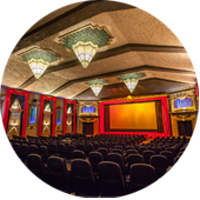
Architect: Lewis A. Smith
First Opened: 9th October 1923 (102 years ago)
Reopened: 17th November 2023
Former Names: Bard’s Hollywood Theatre, New Vista
Website: vistatheaterhollywood.com 
Telephone: (323) 660-6639 
Address: 4473 Sunset Drive, Los Angeles, CA 90027 
The Vista, a single-screen neighborhood movie theatre, opened on 9th October 1923. Originally called Bard’s Hollywood Theatre, opening night consisted of some vaudeville acts and a screening of “Tips” starring Baby Peggy, who made an in-person appearance in for the sell-out crowd of 900.

 Detailed Information
Detailed Information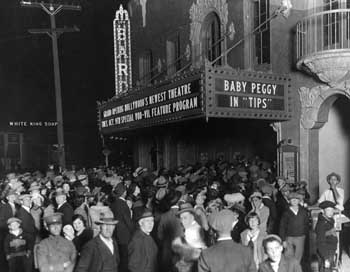
Lou Bard’s movie theatre chain, which built his new Bard’s Hollywood Theatre, would go on to build several other theatres including the 8th St Theatre (later called the Olympic Theatre) in downtown Los Angeles, and Egyptian-themed theatres in West Adams, Glendale, and Pasadena.
The theatre was built as a single-screen neighborhood movie theatre, and although the exterior is designed in Spanish Mission style, Lou Bard loved the Egyptian themes which were all the rage following the discovery of Tutankhamun’s tomb in 1922, and had his architect Lewis A. Smith design an Egyptian interior for the theatre. The highlight was ten eerily-lit life-size pharaonic masks lining the sides of the auditorium.
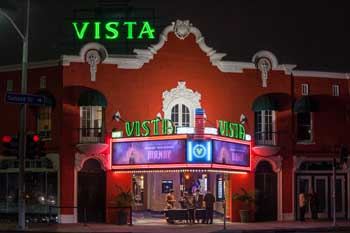
Although originally opening with vaudeville acts and organ concerts, within a couple of weeks of its opening the theatre settled into a pattern of two features per week, a reduction in vaudeville acts – which were often replaced by an organ concert, until finally just films were screened.
According to a post on the Cinema Treasures website  the theatre featured a small Style D Wurlitzer theatre organ (2-manual/6-rank, Opus #701) that was shipped from the Wurlitzer factory in North Tonawanda on 15th September 1923. The organ was later broken up for parts.
the theatre featured a small Style D Wurlitzer theatre organ (2-manual/6-rank, Opus #701) that was shipped from the Wurlitzer factory in North Tonawanda on 15th September 1923. The organ was later broken up for parts.
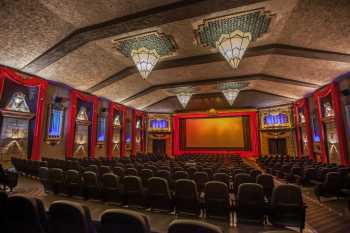
Seating capacity was originally quoted as 838 in the 1920s, however for many years the reported capacity was lower, in the range of 600-700. Current capacity is 400, with every second row of seats having been removed to increase legroom.
By 1930 the theatre came under the new management of Fox West Coast which was when the theatre was renamed as the Vista Theatre. The current neon marquee replaced the original 1923 marquee in 1938 at a reported cost of $1,000.
In the 1960s the theatre was known for screening cult films, however by the mid-1960s became better known as a porno house, moving from soft-core to hard-core and finally gay porn until it was refurbished for revivals in 1980 by the San Francisco-based Thomas Theaters chain.
Thomas Theaters sold the theatre to Landmark Theaters in 1982 and it reopened in as a revival house, however by mid-1985 Landmark could not make the Vista’s programming a success with the direct competition from cable TV and video rentals.
Landmark closed the Vista in 1985, it was sold, renamed the New Vista, and went back to screening first-run movies.
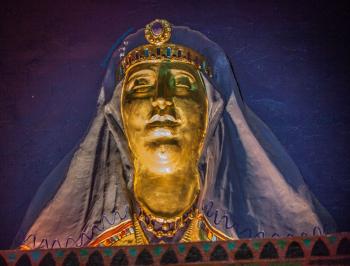
When Five Star Theatres (now Vintage Cinemas) acquired the property in 1993, the Vista was a dilapidated dive with a checkered past. Lance Alspaugh, head of Five Star, was planning extensive improvements when he was approached by designer Ronald Wright, who proposed a complete and thorough renovation and restoration. The floor-to-ceiling process, costing approximately $1 million and including earthquake retrofitting, started in 1997 and was completed in 2000. By going down to the smallest level of detail it took around a year to restore all of the pharaoh masks lining the auditorium. Vertical seismic retrofit strengthening beams are hidden behind the red curtains adorning the pharaoh masks lining the walls, slightly altering the original shape of the auditorium.
Originally there was no hint of the interior Egyptian theme outside the building, however the addition of a new Egyptian-themed box office at the entrance doors, as part of the 1997-2000 refurbishment, firmly planted the Egyptian theme as starting at the entrance lobby.
Like Grauman’s Chinese Theatre, the Vista’s forecourt features cement handprints and footprints, however the Vista’s tend toward icons of independent and cult movies.
The theatre is built on the site used for the massive Babylon set from D.W. Griffith’s biggest and most expensive movie, Intolerance (1916)  . This set is the origin of the design used for the outdoor Hollywood & Highland mall.
. This set is the origin of the design used for the outdoor Hollywood & Highland mall.
The theatre temporarily closed in March 2020 as a result of the Covid-19 pandemic. In early July 2021, Variety reported  that Quentin Tarantino had purchased the theatre and expected to reopen it by December 2021.
that Quentin Tarantino had purchased the theatre and expected to reopen it by December 2021.
In early November 2023 it was announced the theatre would reopen on 17th November 2023, screening Thanksgiving (2023)  in 35mm. A special pre-opening 100th anniversary event, with a screening of True Romance (1993)
in 35mm. A special pre-opening 100th anniversary event, with a screening of True Romance (1993)  hosted by Quentin Tarantino took place on 11th November. Variety reported
hosted by Quentin Tarantino took place on 11th November. Variety reported  that the 400-seat theatre now has a state of the art sound system and 70mm projection capability. It’s intended that the Vista will screen mostly first-run films, as long as a 35mm print exists.
that the 400-seat theatre now has a state of the art sound system and 70mm projection capability. It’s intended that the Vista will screen mostly first-run films, as long as a 35mm print exists.
 Movie, TV & Music Video Appearances
Movie, TV & Music Video Appearances . The Vista features as a movie theatre. Note the green/white lettering in the shop window to the left of the theatre, added for this movie and still in place as of 2018.
. The Vista features as a movie theatre. Note the green/white lettering in the shop window to the left of the theatre, added for this movie and still in place as of 2018. . The movie theatre.
. The movie theatre. . Movie theatre where Chili and Karen see a movie.
. Movie theatre where Chili and Karen see a movie.
 . The Vista was used for the movie theatre interiors however the exteriors were shot at the Rialto in South Pasadena.
. The Vista was used for the movie theatre interiors however the exteriors were shot at the Rialto in South Pasadena.
 . The movie theatre.
. The movie theatre. How do I visit the Vista Theatre?
How do I visit the Vista Theatre?The Vista doesn’t currently offer tours (as of 2025) so check out the theatre’s website  for events playing at the Vista - it’s a popular and busy venue.
for events playing at the Vista - it’s a popular and busy venue.
 Further Reading
Further Reading has lots more details of movies screenings, old postcards/posters and lots of screenshots of The Vista appearing in the movies.
has lots more details of movies screenings, old postcards/posters and lots of screenshots of The Vista appearing in the movies. is the place to go for current events, some history and lots of recent photos of the 1997-2000 renovation.
is the place to go for current events, some history and lots of recent photos of the 1997-2000 renovation. contains many anecdotes about the thetare.
contains many anecdotes about the thetare. .
. affording insight into the Vista’s role in Los Feliz.
affording insight into the Vista’s role in Los Feliz. on 5th July 2021.
on 5th July 2021. Technical Information
Technical Information Photos of the Vista Theatre
Photos of the Vista TheatrePhotographs copyright © 2002-2026 Mike Hume / Historic Theatre Photos unless otherwise noted.
Text copyright © 2017-2026 Mike Hume / Historic Theatre Photos.
For photograph licensing and/or re-use contact us here  . See our Sharing Guidelines here
. See our Sharing Guidelines here  .
.
| Follow Mike Hume’s Historic Theatre Photography: |  |
 |